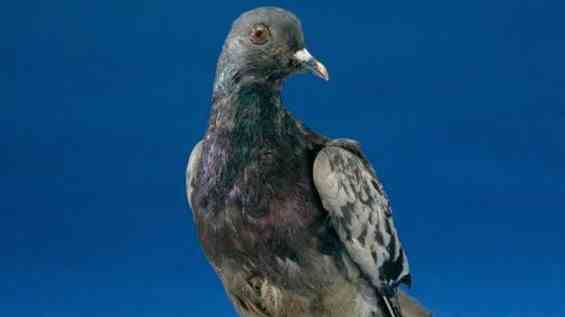Charles Darwin, the evolutionary biologist, appreciated pigeons – unlike the city dweller of the 21st century. Pigeon droppings on the balcony is also an impertinence, then there are the nests and the cooing under the roof, hijacked pedestrian zones, the way to H&M lined with these creatures with small brains, McDonald’s fries and cigarette butts between the claws, little head and a lot of neck and eyes as big as grains, from which speaks nothing but stupidity. Dumb and dirty, that’s the common misconception about these birds. If you had Charles Darwin’s first chapter of the main work “On the Origin of Species” read: a multi-page hymn to the pigeon and its diversity. For his racial research, Darwin had himself admitted to two London pigeon clubs. Ever heard of the “short-faced tumbler”?
Pigeons not only introduce what is probably the best-known evolutionary theory work in history. Pigeons are marvels at navigation and orientation, have excellent visual memories and complex perceptions, are loyal partners – and in some cases even lifesavers. In times of war they were used as spies and messengers, delivering messages when the radio and telegram didn’t work. Such as Emperor, a German military pigeon that was captured by Americans after the outbreak of World War I, retrained and kept as an extremely potent breeder. Or the American pigeon GI Joe, who made a name for himself in World War II. Because of his merits, he was the only foreign pigeon to be awarded the Dickin Medal, an award that was actually only granted to British war animals.
Blind in one eye and with a mangled foot, the pigeon made it to the finish
And then there is the famous carrier pigeon Cher Ami. Its history is no secret, and you can find out more about it at the National Museum of American History and the Smithsonian Institution. But what nobody knew for sure for a long time: Is Cher Ami a hero or a heroine?
Cher Ami was one of 600 US Army Signal Corps carrier pigeons installed in a mobile pigeon loft in France during the Meuse-Argonne Offensive in World War I. On October 4, 1918, a battalion of the US 77th Infantry Division, the “Lost Battalion”, was encircled by German troops in the Argonne, cut off from their own front. The group accidentally came under fire from American artillery, the only means of communication remained pigeons. The leader of the battalion, Major Charles Whittlesey, sent one after the other without success until only Cher Ami remained. Whittlesey tied a message around the dove’s leg. The location, the hopeless situation are noted – and a request. “For heaven’s sake, stop it.” For heaven’s sake, stop the fire. It can be found in the US National Archives.
Shortly after Cher Ami’s departure, the soldiers saw their hope sail to the ground, hit by a hail of bullets. Now the heroic part of the story begins, you have to imagine Hollywood blockbuster triumph music: Cher Ami pulls herself together despite her injuries, keeps flying, covers 40 kilometers in half an hour. Blinded in one eye, shot in the chest and a mangled foot, the pigeon makes it to the base and breaks the news. The fighting shifts, 194 soldiers of the Lost Battalion manage to return to their own ranks. Cher Ami is decorated with the French Order of Croix de Guerre and brought back to the United States. Whether the bird’s rescue operation was actually as dramatic as the reports suggest remains uncertain.
In the laboratory, the bird was examined for sex-specific DNA sequences
Six months after the mission, Cher Ami died in New Jersey. The Signal Corps turned over the carcass to the Smithsonian’s National Museum of Natural History for preservation. There he was autopsied, prepared, stuffed and exhibited in 1921. That the bird was male was simply assumed and not questioned, for what reason. That explains the name again Cher Amifailing that Chere Amie should have been. It is the French greeting at the beginning of a letter: Dear friend.
In truth, the sex of pigeons is fundamentally a mystery and can hardly be seen with the naked eye. It is said that hens are often stronger than hens, and the distance between the laying legs can also be an indication. Only a DNA analysis can provide certainty. The Smithsonian Institution in Washington, which houses the stuffed bird, performed such a DNA analysis in 2021, a hundred years after it was first issued. A scientist from the National Museum of Natural History laboratory and a geneticist took tissue samples from the stump of Cher Ami’s right foot. In the lab, the sample was analyzed for gender-specific DNA sequences using the now infamous PCR test. The result is a confirmation: Cher Ami does not have to be renamed Chère Amie. The bird that saved nearly 200 soldiers’ lives is clearly male.

